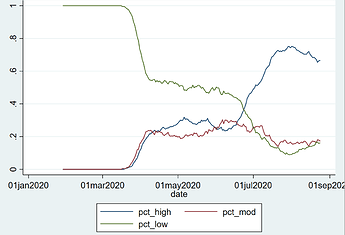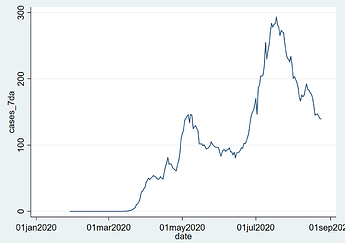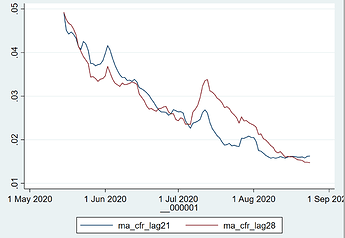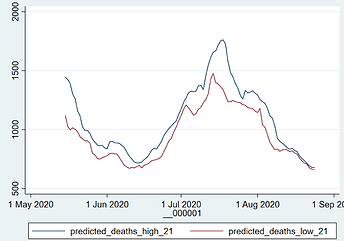Hope he’s wearing goggles
It’s excellent. Idk what are are going to see but so far I have seen enough “fucking boomers” discussion among the youngs that I wonder if junior to high school students will be like the rest of the adult population. By and large considerate and compliant, but a few loud idiots that ruin it for everyone.
What a surprise - the government has gone back to “do whatever you want good luck have fun” mode.
Cases are down, deaths are down, testing is down. If people didn’t approach caring when deaths were higher, methinks this is the end.
Every man for themselves - but the public health response, as…checkered as it was, is officially over.
10 days have now passed since my pcr test. Still no results.
I had to call to get mine, which apparently was completed 3 days before I called.
What the fuck?
I think this idiot made an appearance in one of the earlier COVID threads here. Well, his wife died. I smile when I see these headlines now. Does that make me a bad person?
https://www.yahoo.com/news/man-believed-virus-hoax-loses-171053228.html
Depends on how he acted towards those who didn’t.
Holy shit, I read this as fattest man alive. I thought “Well he’s certainly dead” but wasnt sure how Jamaica or Bolt fit into it.
In conclusion, I don’t read so good.
Since I’m a lazy, filthy casual who basically browses a bunch of already-subscribed topics and that’s it: Did all the numbers and analysis get moved to a different thread, or did everybody just simultaneously get weary of posting about them?
Four scenarios on how we might develop immunity to Covid-19
Menachery laid out four possible scenarios for how humans might interact with SARS-2 over time — in other words, what kind of immunity we might expect.
Some of the terms are of his own creation, so they may not be instantly recognizable to people who have studied immunology. They also cover a spectrum, and the lines between some of the scenarios can be blurry in spots. But they provide a useful discussion starter.
As Menachery sees it, the possibilities for the future when it comes to Covid-19 and human immunity break down as follows: sterilizing immunity, functional immunity, waning immunity, and lost immunity.
Please remember: These are educated guesses, based on what’s known about the way the immune system works in general, and how it responds to other coronaviruses.
Sterilizing immunity
Sterilizing immunity would be a best-case scenario. It describes an immune system that is armed against a foe, able to fend it off before infection can take hold.
Diseases that we think of as “one-and-done” infections induce such a robust and durable immune response in a single encounter that we cannot be reinfected. In general terms, measles fits into this category, although there are rare reports of people contracting measles more than once.
The bad news is that viruses that infect via the mucus membranes of the nose and throat, like SARS-2, typically don’t induce sterilizing immunity.
“Sterilizing [immunity] in my view is out of the question, as with any respiratory virus,” said Marion Koopmans, head of virology at Erasmus Medical Center in Rotterdam, the Netherlands. Stanley Perlman, a coronavirus researcher at the University of Iowa, called this option “not so likely.”
One last observation about sterilizing immunity: If infection doesn’t trigger it, there is reason to be concerned that vaccines may not either. Peiris noted that so far most of the experimental vaccines, when tested in primates, protect the lungs from severe disease but don’t block replication of virus in the upper airways.
If the primates predict how the vaccines will work in people, these studies would suggest that people may still be able to be infected and they may emit viruses that potentially could infect others, but the type of Covid-19 disease that lands people in ICUs and that sometimes kills them would be prevented.
Functional immunity
Functional immunity, on the other hand, may be within reach. In fact, it’s the scenario Menachery sees as most likely.
Under this scenario, people whose immune systems have been primed to recognize and fight the virus — whether through infection or vaccination — could contract it again in the future. But these infections would be cut short as the immune system’s defenses kick into gear. People infected might not develop symptoms or might have a mild, cold-like infection.
“I’m a believer that if you’ve gotten Covid-19, then your likelihood of dying from a second Covid-19 case is very low, if you maintain immunity,” Menachery said.
Peiris agreed. “It won’t have the impact it has now. … It becomes manageable.”
There’s been enormous amounts of debate — and concern — about how long-lasting or “durable” immune responses to this virus will be, based on a few scientific papers that suggest some people don’t develop many antibodies to the virus and others that report that those antibodies appear to decline quickly.
The experts who spoke with STAT all felt that the immune responses to this virus are exactly what you would expect to see. And the case of the Hong Kong man who appears to have been reinfected underscore that, several said.
“The fact that somebody may get reinfected is not surprising. But the reinfection didn’t cause disease,” said Peiris, who knows about the case but was not one of the authors reporting it.
Angela Rasmussen, a virologist at Columbia University in New York who studies human responses to viral infections, said it is hard to be definitive, given the limited human experience with this new coronavirus, but she said she could see no reason to believe the immune system would behave differently to this respiratory virus than to others.
“So far, anyway, the evidence supports functional immunity, but the only way to see how long that will last is to follow people over time and see if those responses diminish,” she said.
“The idea there is that, yes, your antibodies might wane, but your memory responses aren’t absent,” said Menachery, noting that when a primed immune system re-encounters the virus, production of antibodies would kick into gear.
Christian Drosten, who is another co-discoverer of SARS-1, describes a future that fits into this category.
“I clearly expect lasting and relevant immunity that is almost sterilizing immunity against SARS-2 in almost every person infected with SARS-2,” Drosten, director of the Institute of Virology at Berlin’s Charité University Hospital, said via email.
“It may be possible to become infected again, without any change in the virus. The resulting infection will be mild or asymptomatic, with significantly lower levels of virus replication and onward transmission.”
Drosten’s last point would be a big bonus. If people who are reinfected don’t generate high levels of SARS-2 viruses in their respiratory tracts and therefore don’t contribute much to the spread of the virus, Covid-19 may become, over time, not just less dangerous, but also less common.
Waning infection
Waning infection, the third scenario, is a variation of functional immunity. In this scenario, people who have been infected or vaccinated would lose their protection over time. But even if immunity wanes, reinfections would be less severe, Menachery said.
“You will never get as sick as you were the first time,” he said.
The man from Hong Kong may be an example of this phenomenon, though details of his immune responses to his first and second infections are not yet public.
This is the pattern seen with the four coronaviruses that cause about 15% of what we consider common colds — OC43, 229E, NL63, and HKU1. People can be reinfected with these viruses after a relatively short period of time.
Lost immunity
Lost immunity describes a scenario in which people who have been infected would lose all their immune munitions against the virus within some time frame. A reinfection after that point would be like a first infection — carrying all the same risk of severe disease now seen with Covid-19.
None of the experts who spoke to STAT felt this was a possibility.
This article cleared up so many of my questions about the types of immunity and how they might work. I encourage everyone to read the whole thing. I snipped a lot of it.
Cliffs: Most likely people who have had covid or are vaccinated will have what’s called functional immunity, which means we can still catch it but won’t get super sick, and may not even notice it. How much we can spread it in that scenario is unknown. But based on previous respiratory viruses it’s presumed to be less than in someone who has zero immunity.
I have a feeling I’m going to repost this article itt at least a dozen times over the next few months - every time a new article about catching it twice or discussing “immunity” in vague terms coms out. So you might as well just bite the bullet and read it now.
A friend of mine posted on FB the other day that graphic showing that 57% of Republicans are cool with the COVID death numbers. He included a little rant.
I responded, sarcastically, “Pro life.”
A dude didn’t understand that I was being sarcastic and replied, “Ok douche-nozzle. More like pro-fetus. You people that claim you are pro-life make me sick. If you haven’t adopted or at least been a stepparent…well you just need to fuck off.”
Aside from him not getting the point, here’s what I don’t get: what the hell does being a step-parent have to do with being pro-life or pro-choice? It’s like if I was really pro-life, to prove that I cared about people, he wants me to divorce my wife and marry a single mom?
Look how much he loves this new-found status.
I got less interested in looking at the numbers and posting them because things were generally going in the right direction, there didn’t seem to be any obvious shifts, and it wasn’t clear that anyone was getting any benefit from the barrage of data. But maybe it’s worth posting what I think is good news. At the county level, I had been looking at relatively large counties (>=100,000), and classifying them as high/medium/low in terms of 7-day average new case counts:
- High translates to an average of 50 new cases over the prior 7 days per 100,000 population
- Medium translates to an average of 25-50 new cases over the prior 14 days per 100,000 population
- Low is less than 25
The proportion of counties in the high category has recently declined, while the proportion in the low category has recently increased:
Locally, Franklin County Ohio has experienced a major decline in the rate of new cases:
There’s been a lot of fear that students returning to Ohio State University will drive these numbers up, but that hasn’t shown up in the data yet.
Going back to the national level, the estimated CFR for recent cohorts (7-day average deaths divided by 7-day average cases lagged by 21 days or 28 days) continues to decline and seems to be reliably below 2%:
So if we have both a decline in cases and a decline in the recent-cohort CFR, I think we can expect a continuing decline in deaths. This is each day’s high and low estimate of what the 7-day average death count will look like 21 days in the future:
So in my mind, at both the national level and in my local level, we are very obviously moving in the right direction. The trends are very good, but the levels are still bad. As a result, I’m no longer as fearful as I was a month or two ago about how bad things were going to get heading into the fall and winter seasons.
(Obvious knock on wood that opening schools and the upcoming change in season aren’t disasters.)
Yeah, we probably are going to see some kind of bump on a week or two from school reopenings.
Would be at least 2 weeks given the ‘speed’ of US testing
Headlines like the following illustating these students are starting back at school with covid, not catching it there. 7 days to symptoms, 7+ days for a US test result
The University of Alabama in the US has reported 566 cases of Covid-19 since classes resumed a week ago
You can always expect a healthy bump in figures when the parents of these kids can now return to workplace too
Yeah takes 4-5 days to be contagious then a day or two to spread it around then the next gen etc.
If starting from a handful of infected on campus then will take awhile for exponential growth to show up.
If starting from 566 like Bama then it should be visible faster.
Of course, new guidelines to only test if symptomatic may hide some of the numbers, but they’ll still go up if it’s spreading, just be suppressed by a bit.



